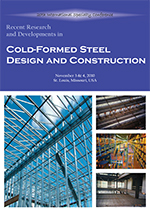Session Dates
03 Nov 2010
Abstract
Cold-formed steel tension members with bolted end connections are frequently used in a variety of structures such as trusses, transmission towers etc. Among all the shapes, angles are widely used. When angle sections are connected with gusset plates and eccentrically loaded, their ultimate load- carrying capacity is influenced by the effect of shear lag. This paper presents the details of an experimental and numerical investigation with a primary objective of studying the effect of shear lag on cold-formed steel single and double angles subjected to tension. Seventy-two single plain and lipped angles made from thicknesses 2,3 and 4 mm connected to gusset plates at their ends by ordinary black bolts were tested. Forty-eight double angles of 3 and 4 mm thicknesses connected to the opposite side of gusset plate and to the same side of the gusset plate at their ends by black bolts were also tested. All the one hundred and twenty specimens were tested in an Universal Testing machine subjected to eccentric tensile load. From the test results, load vs deflection behaviour and the failure modes were studied. The actual load carried by the specimen was compared with the theoretical load carrying capacity predicted by International codal provisions and with the load carrying capacity predicted by numerical investigation by ANSYS. An empirical equation is proposed to determine the load-carrying capacity of the cold-formed steel angles and the predicted values agree with the experimental results.
Department(s)
Civil, Architectural and Environmental Engineering
Research Center/Lab(s)
Wei-Wen Yu Center for Cold-Formed Steel Structures
Meeting Name
20th International Specialty Conference on Cold-Formed Steel Structures
Publisher
Missouri University of Science and Technology
Document Version
Final Version
Rights
© 2010 Missouri University of Science and Technology, All rights reserved.
Document Type
Article - Conference proceedings
File Type
text
Language
English
Recommended Citation
PadmaPriya, R. and Kandasamy, S., "Study on the Behavior of Cold-formed Steel Angle Tension Members" (2010). CCFSS Proceedings of International Specialty Conference on Cold-Formed Steel Structures (1971 - 2018). 10.
https://scholarsmine.mst.edu/isccss/20iccfss/20iccfss-session11/10
Study on the Behavior of Cold-formed Steel Angle Tension Members
Cold-formed steel tension members with bolted end connections are frequently used in a variety of structures such as trusses, transmission towers etc. Among all the shapes, angles are widely used. When angle sections are connected with gusset plates and eccentrically loaded, their ultimate load- carrying capacity is influenced by the effect of shear lag. This paper presents the details of an experimental and numerical investigation with a primary objective of studying the effect of shear lag on cold-formed steel single and double angles subjected to tension. Seventy-two single plain and lipped angles made from thicknesses 2,3 and 4 mm connected to gusset plates at their ends by ordinary black bolts were tested. Forty-eight double angles of 3 and 4 mm thicknesses connected to the opposite side of gusset plate and to the same side of the gusset plate at their ends by black bolts were also tested. All the one hundred and twenty specimens were tested in an Universal Testing machine subjected to eccentric tensile load. From the test results, load vs deflection behaviour and the failure modes were studied. The actual load carried by the specimen was compared with the theoretical load carrying capacity predicted by International codal provisions and with the load carrying capacity predicted by numerical investigation by ANSYS. An empirical equation is proposed to determine the load-carrying capacity of the cold-formed steel angles and the predicted values agree with the experimental results.



